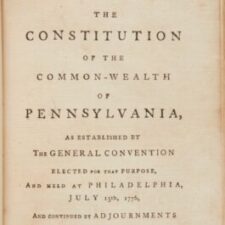 A recent column on the nonprofit news website the Pennsylvania Capital-Star argues that Pennsylvania voters should receive more notice about proposed amendments to the state’s Constitution advanced by Republican lawmakers this year. The column’s author, Patrick Beaty, believes the notice requirements set by the Constitution are insufficient.
A recent column on the nonprofit news website the Pennsylvania Capital-Star argues that Pennsylvania voters should receive more notice about proposed amendments to the state’s Constitution advanced by Republican lawmakers this year. The column’s author, Patrick Beaty, believes the notice requirements set by the Constitution are insufficient.
We have no position on the substance of the amendments or on Beaty’s call for more transparency surrounding the amendment process.
Nevertheless, his column offers an excellent illustration of a major challenge facing the newspaper industry: To reframe the debate around public notice by helping people understand that notices published in newspapers are also published on newspaper websites.
Pennsylvania’s Constitution requires the government to publish newspaper notice of proposed amendments three months before consecutive general elections. The notices must run three times in at least two newspapers published in every county in the state.
Beaty claims the requirement is insufficient because a “large majority of people … don’t read print newspapers on a regular basis.” To buttress his claim, he cites a recent Pew Research Center survey in which only 10 percent of respondents said they “often” get their news from “print publications.”
Leaving aside his cherry-picked presentation of data, Beaty appears not to know that the great majority of newspapers in Pennsylvania also publish notices on their websites and/or on the Pennsylvania NewsMedia Association statewide public notice site.
He is not alone. Few people know that notices are published on newspaper websites. The newspaper industry’s prospects for ensuring that newspapers and their websites remain the official source of public notice depend in large part on spreading that knowledge.
That’s why dozens of state press associations have proposed laws requiring newspapers that publish notices in print to also publish them on the internet at no extra cost. It’s why 18 of those states have passed such laws.
What can you, the newspaper publisher, do to help? Here are four suggestions:
1. Most importantly, run the notices on your website and on your press association’s statewide public notice website
The notices must be published on your website because it has the local readers who those notices are intended to reach. And if your site is like most other newspaper websites, it has a much larger audience than the municipal and/or county government websites in the geographic areas you serve. That disparity in website traffic clearly establishes the potential loss of transparency that government-website notice represents.
You should also publish the notices on the statewide website because there must be a one-stop destination for every notice in the state for people who want to get them that way, and for those who want to subscribe to email or text alerts for specific types of notice. And the site must be sponsored by the newspaper industry, not the government.
2. Make the notices on your website easy to find
At the very least, you should feature a discrete “Public Notice” link in your main navigation index. (We prefer the term “Public Notice” to “Legal Notice” or “Legal Ads” for these reasons.) Don’t just merge the notices with your classifieds section. Nobody who hasn’t worked in the newspaper business will know they can find them there.
3. Market the fact that you publish notices on your website
The easiest way to market website notices is to make them easy to find. Banner or tile ads can help. You should also consider running ads promoting them in your paper as well. PNRC recently created a series of branding-flexible ads you can use (see download link below). Or you can create your own ads. You might also consider mentioning website publication of notices in presentations you or others at your news organization make to local audiences.
4. Report on important notices and refer to them as a source when you do
There is important news contained in many notices. So important, in fact, that your state legislature passed laws requiring them to be published in your newspaper! Train your editors and reporters to know that and to look for local news in your notices. And make sure they cite the notice as a source, e.g., “ … according to a notice published in this newspaper and on our website.” PNRC runs a contest to promote the importance of reporting on notices and we have published a brief document with tips to help journalists learn more about how to do it.
Of course, the importance of the news contained in each notice varies — a point implicitly raised by Beaty in his column. For instance, a notice containing a proposed amendment to the state Constitution is objectively more important than a meeting notice or name-change notice. Does it merit different treatment in your paper or on your website? For instance, should publishers consider graphically highlighting the most important notices in print or “pinning” them on their public notice index page on the web? Perhaps it’s a point worth considering.
The newspaper industry must broadly inform the public that notices published in the print edition are also posted on the paper’s website. Local newspapers are the most effective carriers of the message. It’s our best defense against the encroachment of government websites.
